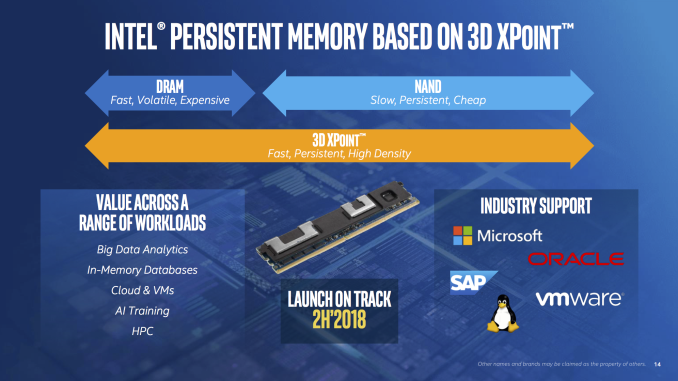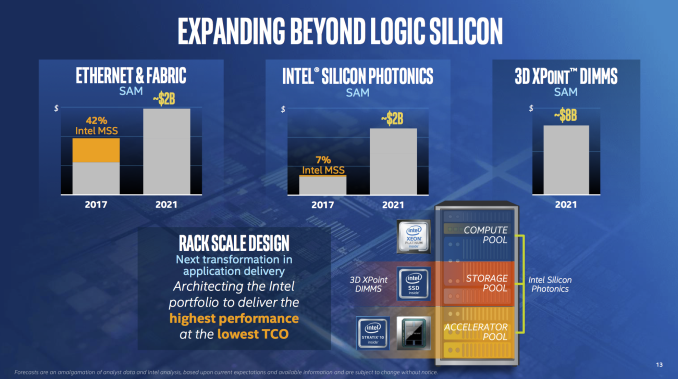Intel To Launch 3D XPoint DIMMs in 2H 2018
by Billy Tallis on November 14, 2017 6:20 PM EST
Presenting at the UBS Global Technology Conference today, Navin Shenoy, Intel Executive Vice President and General Manager of their Data Center Group, shared an update on Intel's roadmap for 3D XPoint DIMMs. Intel claims that they are on track to launch 3D XPoint memory modules in the second half of 2018. They are projecting that 3D XPoint DIMMs will be an $8B market by 2021.
After launching several Optane SSD products this year based on 3D XPoint memory, Intel had said almost nothing about their progress toward 3D XPoint DIMM memory modules. Intel first publicly showed a prototype 3D XPoint NVDIMM in January 2016, only a few months after unveiling 3D XPoint memory itself. When the first Optane products launched earlier this year, we were told Intel would have more to say on the subject of 3D XPoint DIMMs in 2018, but today's announcement makes it clear they will be selling the actual hardware within about a year.
The launch of 3D XPoint DIMMs will depend on several pieces coming together. First, Intel's 3D XPoint memory must be sufficiently mature to meet the performance and endurance requirements of DIMM-based usage. Their Optane SSDs have all used a PCIe and NVMe interface that adds substantial latency overhead and makes it difficult to assess how close the underlying 3D XPoint memory can come to DRAM performance levels. The Optane SSDs are also shipping with relatively conservative write endurance ratings relative to the eventual expectations for 3D XPoint products: The Optane SSD DC P4800X's 30 drive writes per day for 5 years is not significantly higher than high-endurance flash-based enterprise SSDs can provide.
Second, Intel will need to continue increasing production of 3D XPoint memory as their family of Optane SSDs expands and is joined by 3D XPoint DIMMs. Yesterday, Intel and Micron celebrated the completion of an expansion to building 60 of their IM Flash production facilities in Lehi, Utah. This will significantly increase their production capacity of 3D XPoint memory. So far, Intel seems to have been using almost all of the production of 3D XPoint memory for their Optane products while Micron has yet to publicly introduce any mass-produced 3D XPoint-based products. Micron will most likely start announcing and shipping 3D XPoint products under their QuantX brand within the next year, so Intel won't be getting the full benefit of this capacity boost.
Third, 3D XPoint DIMMs will require server platform support because they are unlikely to operate as standard DDR4 DIMMs. The JEDEC NVDIMM-P standard for persistent memory DIMMs has not been finalized and is expected next year. It's not certain whether the 3D XPoint DIMMs will adhere to the NVDIMM-P standard or if they will use a proprietary interface, but either way they are likely to require updated CPU and motherboard support. Intel's recently-launched Xeon Scalable platform can support DRAM+flash NVDIMM-N modules. The launch next year of 3D XPoint DIMMs may foretell a simultaneous refresh of the Xeon Scalable platform.
Source: Intel











58 Comments
View All Comments
extide - Tuesday, November 14, 2017 - link
I wouldn't be surprised if the capability to run these is already baked into the current Xeon SP hardware and just not enabled or perhaps requires a new BIOS to work.PeachNCream - Tuesday, November 14, 2017 - link
Oh wow, thats cool to get confirmation there's going to be 3D XPoint DIMMs next year! I know we're nowhere close to a consumer product, which is where I'd end up seeing it AND it may not make any sense in a desktop or laptop, but it is nice to see something really new and different come out of the research labs.Amandtec - Wednesday, November 15, 2017 - link
The current M.2 Optane Memory effectively acts as your cache drive. Moving them to a DIMM slot could speed them up a whole lot. If their price was halved and their speed was 10x you would potentially have a good product. Problem still remains the top end of the market don't want low speed DIMMS and the bottom half of the market often don't care or even know how slow their HDD based system is.PeachNCream - Wednesday, November 15, 2017 - link
It's just a thought, but if prices fall far enough, 3D XPoint DIMMs could end up serving those bottom-end consumers well by unifying RAM and storage into a single pool. Take those recent Atom laptops with 2-4GB of RAM and 32GB of eMMC storage for instance and just replace all that with 64GB of Optane DIMMs and the end user might have a faster system that costs less because the internals are simpler.ddriver - Wednesday, November 15, 2017 - link
I can totally see it. Atom performance is sh!t, it will be a brilliant decision to make it even sh1ttier by denying it ram and using something orders of magnitude slower instead. Consumerism boner on!Hey intel, give this guy a job. No wonder your mobile device strategy failed - you lak teh genios.
PeachNCream - Wednesday, November 15, 2017 - link
Someone seems kinda grumpy-wumpy today.ddrіver - Wednesday, November 15, 2017 - link
Well Atom was pretty crap. But this thing might actually turn out OK. I mean I'm not an engineer but I doubt Intel would just throw a product out there without some sort of expectation it will do OK. And if not, try try again,rep_movsd - Saturday, November 18, 2017 - link
Today? ddriver can only shit when commenting on an Intel praising article, that makes him grumpy from constipation.Lord of the Bored - Thursday, November 16, 2017 - link
Look at it the other way: How much faster is a slow DIMM going to be than friggin' eMMC?IGTrading - Thursday, November 16, 2017 - link
We honestly believe this tech makes no sense in DIMM applications since we already have these : https://www.anandtech.com/show/12029/micron-announ...So what's the point ?! What's the advantage ?